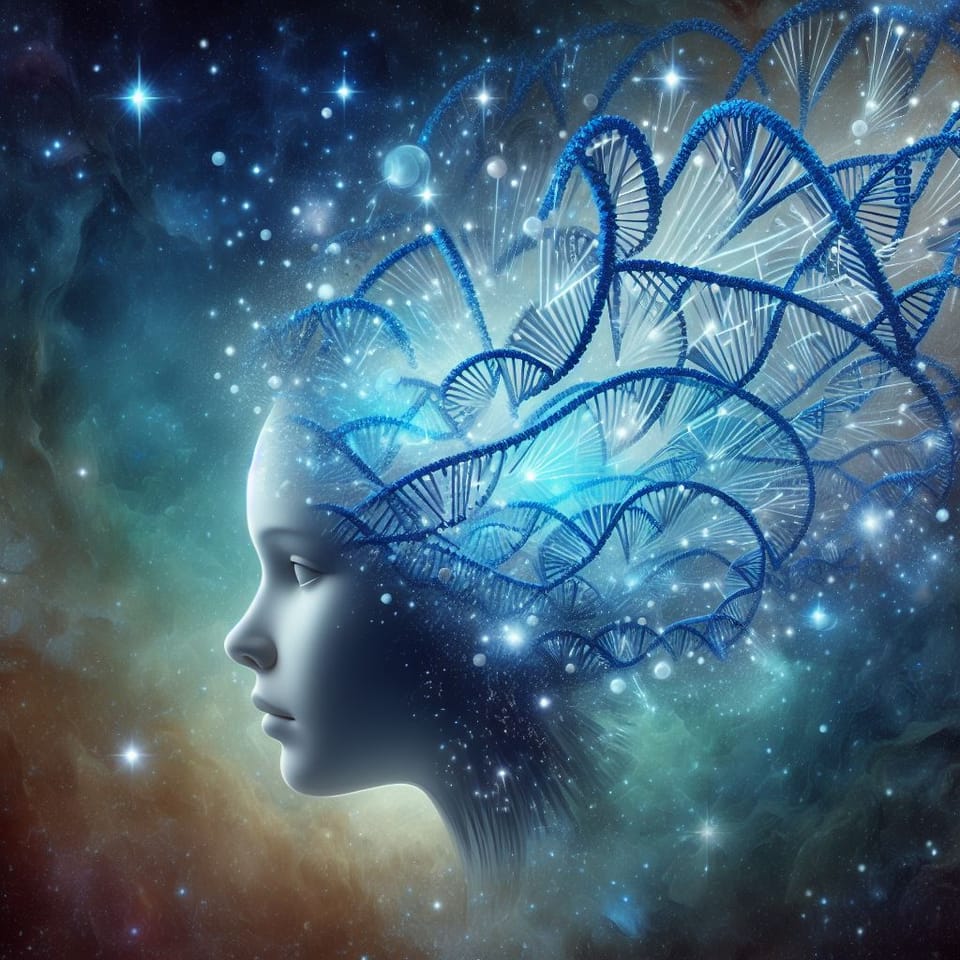A Head Full of Blue Genes

This week we're focused on postpartum depression, the target of my company Dionysus Health.
You want to support my work but don't need a keynote from a mad scientist? Please become a paid subscriber to this newsletter and recommend to friends!
Research Roundup
It's Not Just in Your Head (But Some of It Might Be in Your T-Cells)
Postpartum depression (PPD) might not just be about hormones and sleep deprivation – your immune system could be playing a role.
Healthy postpartum women experience a surge in T-cell activity, particularly helpful TH1 cells and T regulatory cells. Women with PPD, however, don't get this same boost, suggesting their immune systems might be struggling to keep up with the demands of motherhood.
Diving deeper, severe PPD and suicidal are linked with inflammation and disruptions in the immune response. Turns out, inflammation boosts the kynurenine pathway at the cost of serotonin production, contributing to PPD's dark side.
Let's stop dismissing PPD as just "baby blues" and start exploring new treatment options that address the complex interplay between mind and body!
Blue Genes
Our DNA isn't just influencing our risk of depression, it's orchestrating a feedback loop of self harm, but before you resign yourself to a life scripted by your genes, there's good news: modest, cost-effective interventions can dramatically reduce these effects, including postpartum depression and anxiety.
A genetic predisposition for depression doesn't just increase your risk of feeling blue, it can nudge you towards situations and environments that are more likely to trigger those feelings. Like the fungal infections that puppeteer ants into exposing themselves to predators, these genes drive life choices that lead to more anxiety.
On a brighter note, a study in Pakistan showed that providing cognitive behavioral therapy to pregnant women with anxiety led to a whopping 70% reduction in postpartum depression and anxiety. A little support and some coping skills can go a long way changing our choices, no matter what your genes have to say about it.
DNA and epigenetics have real effects on our lives but we can build interventions that empower people to navigate the challenges life throws their way, especially during those vulnerable postpartum months.
Weekly Indulgence

Years ago I made a very early version of a DNN that learned about faces. Its purpose was to reunite orphan refugees with their extended families. I just stumbled across this GIF of its first layer learning a “dictionary” of faces.
Stage & Screen
- Now: “The Disrupted Workforce” interviewed me! We talk through my research on how AI can be leveraged as productive friction for improving teamwork, communities, and our critical thinking and creative capacity.
- Ultimately, we took on the question: Can AI make humanity better?
- 🎧Tune in: https://link.chtbl.com/the-disrupted-workforce
- Apr 16, LA: it's no longer virtual! Come see How to Robot-Proof Your Kids with the LA School Alliance.
- And, here’s the full video episode on their YouTube channel
- btw, I'll be in LA all week: book me at a discount!
- May 8, Boston: chatting with BCG on lifting Collective Intelligence and The Neuroscience of Trust.
- May 1, London: I'm chairing a dinner against homelessness in the UK for Crisis: Venture Philanthropy: The Benefits, How It Works, & How To Get Involved - The Conduit.
- There is an external registration link here.
- May 8-10, Santa Clara: I return to Singularity University
- May 18, Mexico City: I'm giving a keynote for El Aleph, Arts & Science Festival at Universidad Nacional Autónoma de México. ¡Qué bueno!
- May 23, Seoul: keynoting the Asian Leadership Conference! (from last year)
- Mid-June, UK & EU: Buy tickets for the Future of Talent Summit and so much more!
- July, DC: Keynote at Jobs For the Future Horizons!
- Early Bird registration is open.
If your company, university, or conference just happen to be in one of the above locations and want the "best keynote I've ever heard" (shockingly spoken by multiple audiences last year)?
<<Please support my work: book me for a keynote or briefing!>>
SciFri
Science function and fantasy comes in many forms, and so I’m going to plug an unusual one: an improvised science fiction podcast. Mission to Zyxx is a hilarious parody of every trope in scifi but with an obvious love of the genre (except maybe time travel).
The bad news: the podcast ended in 2022 after 5 series. The great news: you can binge the entire thing in 1 self-destructive content orgy. I recommend finding a happy medium between nothing and everything, everywhere, all at once.
Excerpt

Though it received surprisingly little press attention at the time, a letter published in 2015 in the Proceedings of the National Academy of Science presented rather compelling evidence that we are not the only intelligent beings on earth. The authors were not referring to the very standard gaze tracking or mirror test experiments used (sometimes controversially) to assess the cognitive and socioemotional capacity of dogs, chimps, and dolphins. Instead, they had analyzed information processing at a scale fundamentally different from our own in both spatial extent and temporal dynamics. Their argument, far from definitive, was that this being possessed a massive sensory system distributed over more than 100 acres, processing light, vibrations, temperature, moisture, and much more, and that its actions, measured in centuries’ worth of geological and ecological data, clearly revealed complex, latent cognitive states and predictive exploration of its own environment. Compressed to time and spatial scales analogous to our own daily experience, the authors argued, this creature is both undeniably intelligent on a level comparable to humans and social in its conspecific interactions. The authors weren’t talking about dolphins or ravens (or space Krakens); they studied the largest, oldest living thing on the planet: the 6,000 ton Quaking Aspen of Utah.
Although a Quaking Aspen grove looks similar to many other dense copses of trees, its uniqueness is under the ground. Every “individual” tree is a clone of an original, and they are all interconnected in a massively networked root system. The state of every tree and its many senses are communicated in multiple ways throughout this massive network. Just as with our own brains and the massive artificial networks of LLMs, the aspen’s network allows cognition to be distributed throughout the whole system, even when the individual neuron, node, or tree has no such capacity. The authors argue persuasively and with substantial data that these enormous clonal colonies of aspen are awake, behaving, intelligent beings. Yet perhaps the most shocking of their realizations is that we may never be able to communicate with it.
Cognition is embodied. Who we are is determined not simply by our cerebral cortex but by its interaction with its body. Our diverse bodies influence our sense of self in deep ways. In virtual reality (VR) experiments, a change as simple as being in a smaller virtual body causes people to act more passively and take fewer chances. Men embodied as women in VR show decreases in gender bias, and similar decreases are seen across racial groups. Emotions influence and are influenced by the state of our bodies. The relatively subtle differences in bodies across people produce meaningful differences in our experiences with the world. Intelligence “just like ours” but expressed through a completely alien body might well be completely alien.
The Quaking Aspen shares almost nothing in common with our embodied experience. Day passes into night. Summer into winter. Beyond the daily and seasonal cycles of light and dark, cold and warmth, however, most of us experience a world of images and sounds that the aspen have no means of perceiving. We rush through a world that changes minute by minute where the aspen’s world is nearly frozen by comparison. Yet while our experiences may seem rich in the moment we only experience a tiny sliver of the world at any given time. The Quaking Aspen experiences a body spread over acres but has no hands or ears. It moves slowly over decades of growth but cannot walk. It senses subtle changes in light and temperature across that entire body. What would you see with an eye the size of a city?
There are no conversations for the Quaking Aspen. It broadcasts chemicals to the wind, which can travel for hundreds of miles before being “heard”. Its thoughts are the slow processes of their root system’s cellular transportation network, taking months where our neural impulses take fractions of seconds. Strolling through it’s dappled grove we are mites moving at relativistic speeds, as immaterial to its plans for the future as the biomes inside our own bodies are to ours. We cannot talk to the aspens or understand their motivations, and they seem to know nothing of us.
Now let’s be clear, the story above about a superintelligent grove of trees is complete and total bullshit.
Find out why when Robot-Proof hits the shelves!
| Follow more of my work at | |
|---|---|
| Socos Labs | The Human Trust |
| Dionysus Health | Optoceutics |
| RFK Human Rights | GenderCool |
| Crisis Venture Studios | Inclusion Impact Index |
| Neurotech Collider Hub at UC Berkeley |




